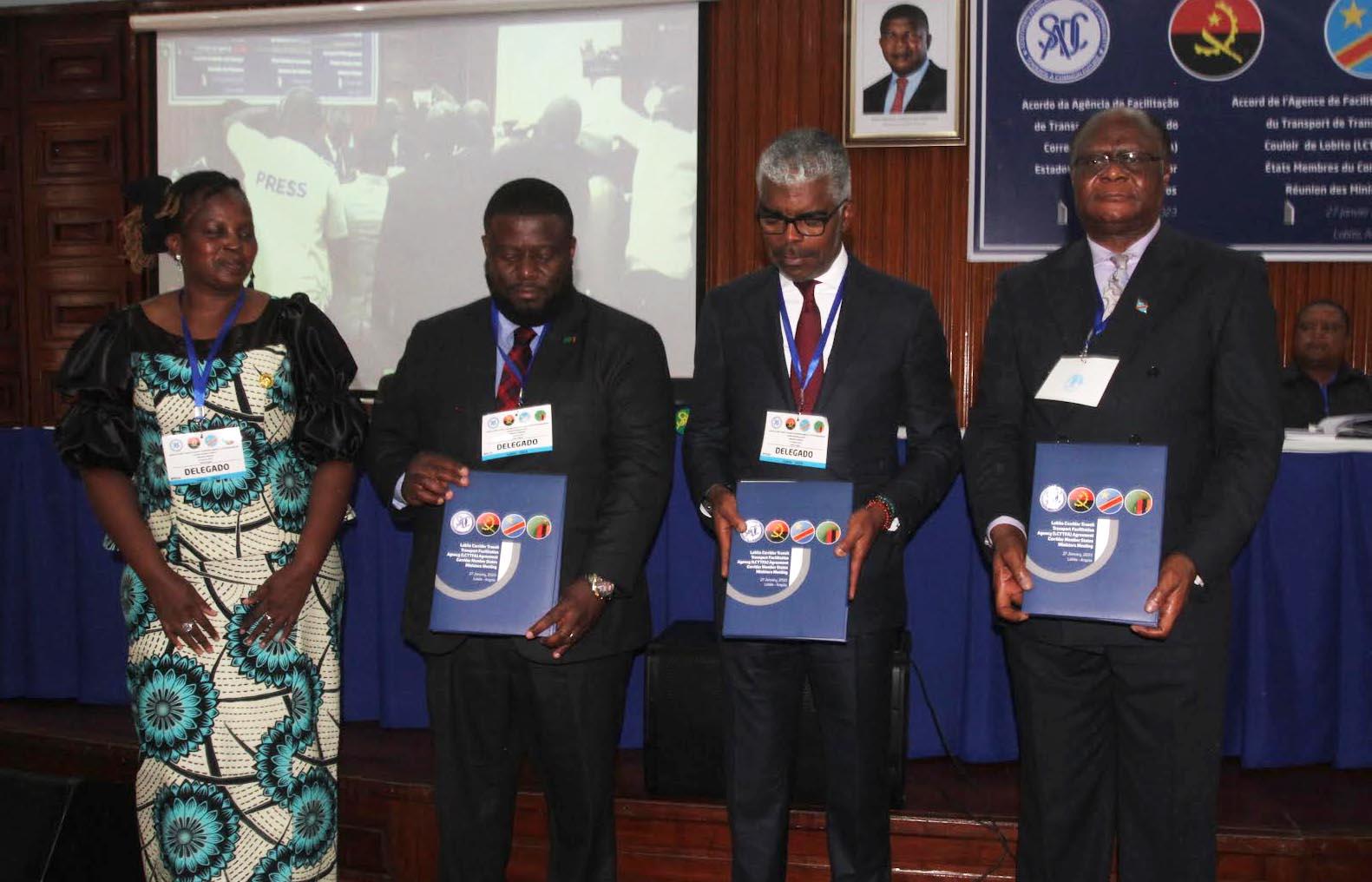Africa-Press – Angola. A Tripartite Agreement between Angola, the Democratic Republic of Congo (DRC) and Zambia, to boost the movement of goods and promote the mobility of citizens along the Lobito Corridor, was signed this Friday.
The Ministers of Transport of Angola and Zambia, Ricardo Viegas D’Abreu and Franck Tayali, respectively, and the Ambassador of the Democratic Republic of Congo in Angola, Kalala Constantin, representing the government of his country, signed the Tripartite Agreement, which creates the Lobito Corridor Transit Transport Facilitation Agency (LCTTFA).
This partnership will allow landlocked countries in the region, namely Zambia and the DRC, to use, without constraints, the logistics and transport infrastructure of the Lobito Corridor, which includes the Port of Lobito and the Caminho -de-Ferro de Benguela (CFB), to ship exportable goods.
The circulation of minerals, such as copper and cobalt, from the rich mining areas of Katanga (DRC) and Copperbelt (Zambia), to the Port of Lobito, where they will be exported to the international market, will boost cross-border trade, which will result in in increasing customs revenues for Angola.
Speaking at the signing ceremony of the agreement, witnessed by the Director of Infrastructure of the Executive Secretariat of the Community for the Development of Southern Africa (SADC), Mapolao Rosemary Mokoena, the Angolan Minister of Transport considered “a historic moment”, the creation of the Agency, 12 years after the start of the tripartite negotiations.
Ricardo Viegas D’Abreu pointed out that the agreement will allow the transport of unprocessed or even processed mineral products from exploration, in the Copperbelt region, in the descending direction (Luau/Lobito), of refined petroleum derivatives (diesel and gasoline), in the upward direction (Lobito/Luau), with a view to meeting import needs for domestic consumption in Zambia and the Democratic Republic of Congo.
He also highlighted the essentially regional transport service for general cargo and containers, between the main points of trade, along the length of the Lobito Corridor.
Still according to the minister, the agency assumes a central role in materializing the necessary conditions for a greater integration of the economies of the three States and of the region as a whole, promoting commercial exchanges and investment opportunities.
It considered itself to be facing “the potential for opportunities”, for a joint population of 140 million inhabitants, more than 40 percent of the entire southern region, with the ability to boost a global Gross Domestic Product (GDP) of the three countries of approximately $177 billion, which corresponds to 25 percent of SADC member states.
The impact of the initiative, he added, will have a greater impact on the populations that the corridor crosses, particularly in the provinces of Benguela, Huambo, Bié and Moxico, in Angola, and in the regions of Kolwezi, Likasi or Lubumbashi, in the DRC, and in Solwezi, Kitwe or Ndola, Zambia.
“Our Government attaches special importance to the Lobito Corridor, because it understands that this infrastructure has a fundamental role in the socio-economic context of Angola and the region”, he said, stating that the corridor provides logistical access for the import of critical consumer goods for the interior.
This corridor serves as a catalyst for domestic production, improving logistics for importing raw materials and exporting final products, explained the minister.
Another advantage pointed out by the Angolan Minister of Transport is the fact that the Lobito Corridor has become an alternative for transporting passengers to and from the interior, thus contributing to economic growth.
A strategic corridor for development
With privatized management, for a period of 30 years, through the “Lobito Atlantic Railway” consortium, formed by the companies Vecturis, Trafigura and Mota Engil, the Lobito Corridor covers the Port of Lobito, the Mineiro Terminal and the Caminho-de- Ferro de Benguela (CFB), whose railway currently extends for 1,344 kilometers in length, to Luau, in Moxico.
Given the strategic role for regional economic development, more than two billion dollars were invested in the rehabilitation and modernization of infrastructure and traffic in the Lobito Corridor, with a view to boosting the transport of various goods, benefiting the three bordering countries .
The transport of minerals, such as copper, exploited in the DRC and Zambia, is one of the ways to make the CFB profitable, in particular.
The government already has in its portfolio the completion of the feasibility study for the construction of the 259-kilometre line, which will connect Angola to Zambia, starting from the municipality of Ruacano (Moxico), to the border region of Jimbe (Zambia), a process which awaits, until now, the launch of a public tender.
The recovery of the railways in Zambia and DRC is fundamental, to allow their interconnection to the CFB, in the Luau area, on the Angolan border and, with that, revitalize the transport of ore to Lobito.
Regarding the two main infrastructures of the corridor, namely the Commercial Port of Lobito and the CFB, the two structures prepared themselves to face the challenge that lies ahead, with the increase in cargo movement in the region.
The chairman of the Board of Directors of the Port of Lobito, Celso Rosas, said that his company recorded, in 2022, a 19 percent reduction in ships and a five percent increase in tons, compared to 2021, when it handled 401 ships and one million 487 thousand 606 tons.
Regarding containerized cargo, there was a reduction, in relation to 2021, of around 20 percent, moving 22,578, in 2022, against 28,233, in 2021.
The Benguela Railway registered, in terms of goods, 276 thousand 829 tons of different products, registering an increase of 25 percent, compared to the previous year.
Currently, the hope for growth for Lobito is deposited in the set of public investments in two strategic infrastructures, namely Porto Comercial do Lobito and CFB, considered to be part of the main pillars of development in Angola.
In the post-crisis era and, depending on changes in the global economy, Lobito could quickly resume economic growth, taking advantage of the capacity of its logistics infrastructure and maritime and rail transport, modernized with the latest technology.
On the Zambian side, it is necessary to build around 300 kilometers of railway line to connect the Angolan border, in Luau, and connect to the CFB.
The Agreement to create the Lobito Corridor Transit Transport Facilitation Agency will accelerate the growth of domestic and cross-border trade, through the implementation of harmonized trade facilitation instruments, strengthening the coordination of joint development activities in the corridor and promoting the effective participation of small and medium-sized companies in value chains, defend the authorities.
The Lobito Corridor presents a strategic alternative route to the Zambian and DRC export markets and offers the shortest route linking the main mining regions of the two landlocked countries.
In Angola, the Corridor connects 40 percent of the country’s population and several large-scale investments are under way in agriculture and commerce in the provinces of Benguela, Huambo, Bié and Moxico, regions crossed by the CFB.
The signing of the legal instrument creates a framework for the three SADC Member States to jointly develop harmonized laws, policies, regulations and corridor systems, including the development of infrastructure in a coordinated and consistent manner in line with the SADC Treaty, Protocols and frameworks development plans such as the Regional Indicative Strategic Development Plan 2020-2030.
For More News And Analysis About Angola Follow Africa-Press






